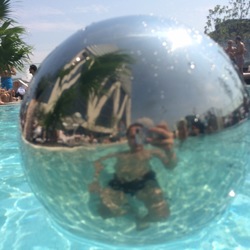Bears&
Gemstone Vineyards
Estate Selection Cabernet Sauvignon 2011
Lions & tigers & bears!!! Sophisticated, but fun - super slutty! Waited too long to drink this!! — 8 years ago
La Grapperie
Adonis Coteaux du Loir Pineau d'Aunis
Light effervescence, alive, moving on the pallette. Bears some similarity to Corniellsen's Contadino but with less Etna smoke. A little boarish (would pair well with a boar stew, manchego cheese) — 8 years ago
Chappellet
Mountain Cuvée Proprietor's Cabernet Sauvignon Blend 2014
Crazy motley of aromas going on here. Cherries, blackberries, cedar, and gummi bears on the nose. On the palate, vanilla, black currant, cloves, dark fruits, red fruits, I could go on and on. Smooth, spicy finish. Straight Bordeaux here. It's nice to drink wine made by people who know what the heck they're doing. — 9 years ago
Amalie Robert
Willamette Valley Pinot Meunier 2013
I love Oregon wines! This is a Pinot Meunier! I can drink this all night long! Amalie Robert 2013 Oregon Pinot Meunier! Fantastic!!!! The cork was perfect. The color is cherry red. The legs are thin yet long. The bouquet is cherry pie and roses. The initial palate is cherry, apple, with a hint of spice on the tip of the tongue. The finish is long and dry for such a light wine. I have hints of cranberry, cherry, and gummy bears - the red ones. I literally cant stop drinking this wine. I have almost finished the entire bottle by myself! Good grief! I will definitely go to the web site and order a case!!!!!!!!
perfection...
— 9 years ago
Marotti Campi
Luzano Verdicchio dei Castelli di Jesi Classico Superiore 2014
Lemon zest, lime pulp, white gummy bears, gardenias. Snapping acidity, oily texture, light bodied, crisp slightly bitter finish. — 9 years ago
Domaine Philemon
Perle Gaillac 2013
Lime pulp, gardenias, wheatgrass, white gummy bears. Great acidity, slight effervescence, oily texture, crisp dry mineral citrus finish. Soft, fairly neutral wine. Pairs wonderfully with green goddess salads, light pastas, and mussels. Organic Blend of 60% Loin de L'Oeil 20% Muscadelle 20% Sauvignon Blanc. — 10 years ago
Bodegas Franco-Españolas
Bordón Gran Reserva Rioja Tempranillo 2005
Campari
Cynar Ricetta Originale Artichoke
For all the koala bears... — 11 years ago
Bodegas Obanca
Castro de Limés Carrasquín
Extreme winemaking in the Liebana valley in Asturias (a mountainous region in Atlántico Spain best known for cider. Mineral, atlantic, fresh, plenty of red fruit, cherries and toasted coffee. A great discovery. Local bears also love the grapes. Fine acidity and great length — 12 years ago
Sean Minor
Four Bears Napa Valley Cabernet Sauvignon 2016
Enjoyed the oak! — 7 years ago
Shafer Vineyards
Red Shoulder Ranch Chardonnay 2013
Grabbed another bottle! Wine bears the vineyard named to honor the Red-shouldered Hawks and other birds of prey that play a vital role in sustainable farming practices. Bright yellow with aromas of tropical fruits and sweet floral scents. Aged for 14 months, 75% in new French oak and 25% in stainless. On the palate melon, pineapple and peach flavors and hints of citrus, subtle yet complex and well balanced. Lingering finish, savory, ending with mineral tones and toasty oak. Outstanding! — 8 years ago
Foley Johnson
Estate Bottled Rutherford Cabernet Sauvignon 2010
Enjoyed fireside in Joshua Tree paired with gummi bears. — 9 years ago
Cantine Polvanera
Minutolo Puglia Fiano 2014
Gardenias, carnations, honeydew melon, papaya, kiwi, white gummy bears, saline, ocean breeze, jasmine. Highly aromatic, rounded acidity, medium bodied, juicy/slightly oily texture, herbal/slightly bitter finish. A bouquet of flowers in a glass, much like a Muscat. — 9 years ago
Sean Minor
Four Bears Vin Gris Carneros Pinot Noir Rosé 2013
Very fine Rose. Yum. — 10 years ago
Heredad Viña Carles
Crianza Priorat Garnacha
Chocolate covered gummy bears — 10 years ago
Christian Salmon
Alfio Moriconi Selection Cuvée Vieilles Vignes Sancerre Sauvignon Blanc 2013
Love me some Sancerrre: for me this is the Goldilocks of white wine: not to sweet, not to dry...just right. If she had this with the porridge, the Bears would have approved! — 10 years ago
Sean Minor
Four Bears Carneros Pinot Noir 2016
Smokehouse berry nose with piney undertones. Big holiday berry mouth upfront with a soft long finish. Pleasing way to begin a winter night. — 8 years ago
Clarendon Hills
Brookman Syrah 2005
On the nose; ripe, syrupy dark currants, blackberries, sweet slightly liqueured dark cherries, black plum, black raspberries, blue fruits, dark fruit gummy bears, tarry notes, black pepper, soft leather, dry brush, black licorice, caramel, dry crushed rocks, loamy dry top soil, violets, lilacs and lavender. The body is warm, thick, ultra rich, lush & elegant. The tannins are round & velvety but still have strength...50% resolved. It has another 10-12 years of good drinking ahead. The fruits are gorgeous & ripe; blackberries, sweet slightly liqueured dark cherries, black plum, black raspberries & lots of blue fruits & strawberries that paint the palate on the long set. A fair amount of tarry notes, black pepper, dry herbaceous notes (bay leaf), dry black olive, medium dark spice, dark chocolate, caramel, vanilla, clove, soft leather, dry brush, black licorice, dry crushed rocks, loamy dry top soil, violets, lilacs and lavender. The acidity is round & excellent. The long fruit driven finish is beautifully lush, elegant, well structured with near perfect balance. Photos of; Owner/Winemaker Roman Bratasiuk, their old gnarly 80-90 year old and low yielding vines and two of their vineyards. Producer history and notes...Clarendon Hills was founded in 1990 by Biochemist Roman Bratasiuks. Roman sought to further his passion for great wine by making some himself. Roman never trained as a winemaker. He planned on using his insight as a wine taster and scientist alike to dictate decisions. Roman sought to make a version of the wines he loved. The beginnings of Clarendon Hills effectively started in 1989 when he knocked on the door a local grower whose fruit he liked. A great friendship grew from from this by chance knock on the door. A handshake ensued and it became the first Clarendon Hills vineyard. On Saturday 24 February in 1990, Roman with just a bucket and secateurs arrived. Much to the growers shock, he began picking fruit himself. Roman started at 6 am and finished at 9 pm that evening; he picked half the entire vineyard himself and returned on Sunday the 25th to finish it. This process was repeated in a Merlot and Cabernet Sauvignon vineyard which formed the 3 single site wines produced in 1990. Crushing was performed by Roman using empty bottles to squash the fruit in a bucket, then transferred by that bucket, to one of the 3 small ex-dairy tanks all bought for $100 and a quick, non-temperature controlled wild-yeast fermentation ensued. The wines were pressed in a borrowed basket press and matured in 3 separate third-hand barrels. The vintage was finished in 11 days. Much to Roman’s delight the wines were superb and they sold. With the money he bought more buckets, three more barrels and rent for a shed to house wines. The process was repeated the next year and the year after that. Clarendon Hills grew from his determination. This one man had to make wine after work and on the weekends after his 9-to-5 job. A local news paper even ran a story "Tin shed wines take on the world"; which made Roman cringe but slowly Clarendon Hills grew, it afforded him more equipment to make the process less labour-intensive and slowly grow his vineyard repertoire. In 1994, Roman left the Australian Government laboratories and devoted himself to Clarendon Hills 100%. In the 1994 vintage, Roman hired his first employee and rebranded his $30 Clarendon Hills Shiraz as 1994 Clarendon Hills Astralis. It was the first bottle in Australia to be priced at $100. It sold out. Roman went on for many years, making and selling the wines himself. Travelling the world over to show people the wines he made. Roman figured since he made the wine, he was the most logical choice to sell and represent his wine. This worked out so well, he continues to show the wines himself. Clarendon Hills produces; 8 Syrah, 6 Grenache, 3 Cabernet Sauvignon, a Merlot and Mourvedre wine. They are all single vineyards single varietal wines, produced from low yielding, dry grown old vines which are hand pruned and hand picked. All his wines are aged in high-quality French oak barriques. Quite a brilliant success story. This is also another wine I acquired on the secondary market for much less it’s release price and far less than their current release prices. It starts as a 9.3 with a half-hour decant. However, as it gets to an hour and half decant plus, it just gets better & better. Works it’s way to a 9.5 in a hour decant. — 8 years ago
Ca' Montebello di Scarani Luigi
Oltrepò Pavese Pinot Nero 2015
Honeydew melon, rhubarb, gardenias, kiwi, almonds, gummy bears, saline, sea shells. Rounded acidity, lean body, mouth coating oily texture, floral slight berry notes on finish. Highly gulpable, excels with delicate scallop preparations. — 9 years ago
Pierre-Yves Colin-Morey
Les Combes Saint-Aubin 1er Cru Chardonnay 2009
Ridiculous value and one of the best Saint aubin wines I've had to date. This stuff is incredible. Almost premier cru puligny in character. Hell this is better than what a lot of producers pass as their grand cru offerings. It bears a light touch of oak around a core of mandarin orange, tropical fruits and creme brûlée.... Sublime! — 10 years ago

Cereghino Smith
Eaten By Bears Red Blend
Full bodied, with hints of Syrah. On the pricey side but well worth it. Hard to find. — 10 years ago
Bread & Butter Wines
Napa Valley Pinot Noir 2013
11/8/14 bears den, CO with Shamps — 11 years ago
Cantillon Brewery
Zwanze Tripel 2013
Jean Van Roy's amazing story of Zwanze 2013. When we started renovation works in the cellars of the brewery two years ago, much to our surprise we came upon the remains of some very old walls. In agreement with the medievalists of the city of Brussels, the works were stopped in order to allow archaeological excavations to take place.
Shortly thereafter we were astonished to find out that Cantillon brewery had in fact been built on the ruins of the very ancient Abbey of Cureghem! According to the medievalists, this religious community was well-known during the middle ages for its fowl fed on draff and, more specifically, for its dish of stuffed Cureghem capon, which was served with a beer brewed at the abbey and apparently drew pilgrims from all over Europe.
Yet it was truly a heavenly surprise when the excavations uncovered the cell of the abbot, Father Faro. In the small room the archaeologists found quite a few old reference books, one of which contained the original recipes for the beers brewed at the abbey several hundred years ago. We didn’t hesitate for a second and decided on the spot to recreate one of these mythical beers.
This beer, which will be our Zwanze for 2013, therefore bears the name of its illustrious place of origin, Abbaye de Cureghem (Cureghem Abbey). Cureghem was formerly a village established many centuries ago on the banks of the Senne, the river running through present-day Brussels. The area was very heavily industrialised during the 19th century and, among other things, became home to many breweries. Today, it is part of the municipality of Anderlecht.
Since beers commonly referred to as “abbey beers” are not, or not any longer, products of spontaneous fermentation, we decided to brew a top fermentation beer, from a technical point of view in any case. The yeasts were selected in collaboration with Institut Meurice, a post-secondary college in Brussels specialising in biotechnology. Brewed in March 2012, our “Cureghem” beer fermented four weeks in stainless steel tanks before being blended with 10% lambic and pumped into 400-litre barrels of various origins. After maturing for six months, the beers were blended and put into casks or bottles to undergo re-fermentation and reach 7.2% ABV (Alcohol by Volume).
Inevitably, a top fermentation beer brewed in a spontaneous fermentation environment will be affected by the wild yeasts in the air, and this is certainly what happened in our case. For our Cureghem, the cultured yeasts were clearly the main factor behind primary fermentation and I think that the wild yeasts in the beer will instead play an increasingly important role as the product ages. However, despite the addition of the lambic to give it a little “extra something” in terms of character and ageing characteristics, this Zwanze cannot in any case be considered a spontaneous fermentation beer.
The long fermentation period coupled with the presence of wild yeasts lends this beer a solid character with a dry finish that lingers on the palate, while the combined use of fresh and aged hops yields both freshness and bitterness. Moreover, the different malts used give this year’s Zwanze a coppery colour along with a touch of caramel and candied fruit that provide body. Clearly, this is not your standard “abbey” beer but, perhaps, it is representative of what these beers were one or two hundred years ago — 12 years ago





















Yarrow Beydoun
Smelled of gummy bears, wild strawberries and raspberries, light citrus notes. Beautiful minerality, fresh and lively. One of the loveliest Rosés I’ve had — 7 years ago